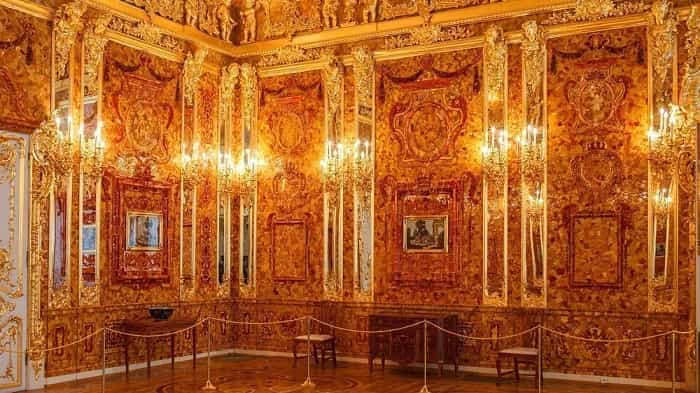The Amber Room: The World’s Greatest Lost Treasure, Mystery, History, WWII, Stolen Artifacts

The Amber Room was once called the “Eighth Wonder of the World” and was one of Russia’s most treasured masterpieces. It was a stunning room filled with amber panels that dazzled everyone who saw it. But during World War II, it was stolen, and to this day, no one knows where it is.
During World War II, Adolf Hitler’s Nazis stole millions of pieces of artwork from across Europe. They looted museums, palaces, and private collections, and many of these treasures were lost forever. Some have been returned, but one of the most valuable and famous of them all, the Amber Room, is still missing.
This article will explain the fascinating history of the Amber Room, its mysterious disappearance, and the ongoing search to find it.
The Creation of the Amber Room
The Amber Room was not just any room; it was a masterpiece. It was made of amber, a special material that comes from tree sap that has been turned into stone over millions of years. Amber is often found in the Baltic region of Europe, and it was highly prized for its beautiful color and glow. The Amber Room was considered so important that it was called a treasure of Russia.
The Amber Room’s story began in 1701, when a German artist named Andreas Schlüter started designing it. At that time, Schlüter worked for the Prussian royal family. He was a famous sculptor and architect, and he wanted to make something truly unique for the Prussian king, Frederick I. Schlüter’s idea was to create a room covered in amber panels, something that had never been done before.
Schlüter asked another expert, a Danish craftsman named Gottfried Wolfram, to help him. They used a special technique to shape the amber and cover it with gold and silver. They added precious jewels to make it even more magnificent. This beautiful room was installed in the Charlottenburg Palace in Berlin, Germany.
The Amber Room Moves to Russia
In 1716, the Russian Tsar, Peter the Great, visited the palace and fell in love with the Amber Room. He wanted it for himself, and so the Prussian king decided to gift the room to the Russian tsar as a sign of friendship between the two countries. The Amber Room was taken apart and sent to Russia, where it was reassembled in the Catherine Palace in St. Petersburg.
Over the years, many other craftsmen worked on the Amber Room, adding to its beauty. By 1770, the Amber Room was completely finished, and it was huge—over 590 square feet in size, covered in six tons of amber! It became one of Russia’s most famous treasures, admired by people from all over the world. It was even said that the Amber Room’s value today could be anywhere between £120 million to £240 million!
The Looting of the Amber Room
During World War II, Germany invaded the Soviet Union, and the Nazis quickly marched towards St. Petersburg, which was called Leningrad at the time. As the German army got closer, the Russians were afraid the Amber Room would be stolen. The room was very precious, and they knew the Nazis would want it.
An art expert named Anatoly Kuchumov was tasked with protecting the Amber Room. He decided to hide it by covering the walls with wallpaper, hoping the Germans would not notice it. Unfortunately, his plan did not work. The Nazis found the room and stripped the amber panels off the walls. Within 36 hours, the precious room was packed up and shipped to Germany.
The Amber Room was taken to Königsberg (now called Kaliningrad, Russia), where it was displayed in the Königsberg Castle for the German people to admire. But by 1944, as the war turned against Germany, the Nazis decided to move their stolen treasures, including the Amber Room.
The Mystery of the Amber Room’s Disappearance
In 1944, the Royal Air Force (RAF) bombed Königsberg, causing massive damage to the city. Artillery fire also hit the city, and the Soviets were advancing toward it in 1945. The Königsberg Castle, where the Amber Room was displayed, was destroyed in the bombings. After the war, when the Red Army entered the city, the Amber Room was nowhere to be found.
The mystery of what happened to the Amber Room began. Some believe it was destroyed in the bombings and the fires that followed. Professor Alexander Brusov, a Soviet expert who was tasked with recovering stolen art, thought this was the case. He claimed that he had found the burnt remains of some pieces of the Amber Room in the castle’s cellar. However, Kuchumov, the man who had failed to protect the room in 1941, refused to accept this theory. He believed the room was still out there somewhere.
Over the years, many other theories have been proposed. Some said the Amber Room was hidden in tunnels beneath Königsberg, while others believed it had been secretly transported to other places, like salt mines in the Czech Republic or even shipped off to the United States. One wild theory suggested that the Soviet Union had built a fake Amber Room to fool the Nazis!
In 1997, a small part of the Amber Room was found—a piece of a mosaic that had been taken by a German soldier in 1941. It had been passed down through the soldier’s family and was finally recovered by German authorities.
The Search for the Amber Room
For many years, people have tried to find the missing Amber Room. Some have even risked their lives in search of it. One man, a former German soldier named Georg Stein, dedicated his life to finding the Amber Room. Sadly, he was murdered in 1987 under mysterious circumstances.
In 2004, two British journalists, Catherine Scott-Clark and Adrian Levy, published a book about the Amber Room. They believed that the room was destroyed in the bombings of Königsberg, and that the Soviet government had covered up the truth. Their research suggested that the KGB had launched an investigation into the missing Amber Room, but their real goal may have been to cover up the fact that the room was destroyed.
In 1968, the Soviets even ordered the destruction of Königsberg Castle, which made it impossible for anyone to investigate further. Some believe the disappearance of the Amber Room was used as propaganda during the Cold War to make the Soviet Union appear like a victim of the Nazis.
The Replica of the Amber Room
Despite the loss of the original Amber Room, the Russian government decided to create a replica. In 1979, they started working on a new version of the Amber Room. It took 24 years and cost over $11 million to complete. The replica was installed in the Catherine Palace in St. Petersburg in 2003. While it is not the original, it is a close replica that gives people an idea of how beautiful the Amber Room once was.
The Amber Room remains one of the most fascinating mysteries of World War II. Its disappearance has captured the imaginations of people around the world for decades. While the replica in Russia gives us a glimpse of its former beauty, the original Amber Room is still lost, and many believe the search for it is far from over.
FAQs
1. What is the Amber Room made of?
The Amber Room is made primarily of amber, a fossilized tree resin. It also includes gold, silver, and precious jewels.
2. Where was the Amber Room originally located?
The Amber Room was originally installed in the Catherine Palace near St. Petersburg, Russia.
3. When was the Amber Room stolen?
The Amber Room was stolen by the Nazis in 1941 during World War II.
4. Has the Amber Room been found?
No, the Amber Room has never been found. Its fate remains a mystery.
5. Is the Amber Room still valuable?
Yes, the Amber Room is considered to be one of the most valuable lost treasures in the world, with an estimated worth between £120 million to £240 million.
6. Was a replica of the Amber Room created?
Yes, a replica was completed in 2003 and is now displayed in the Catherine Palace.
